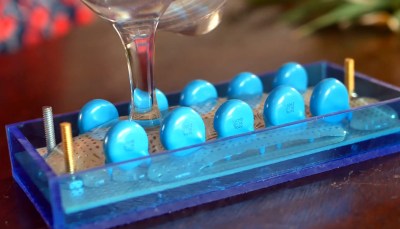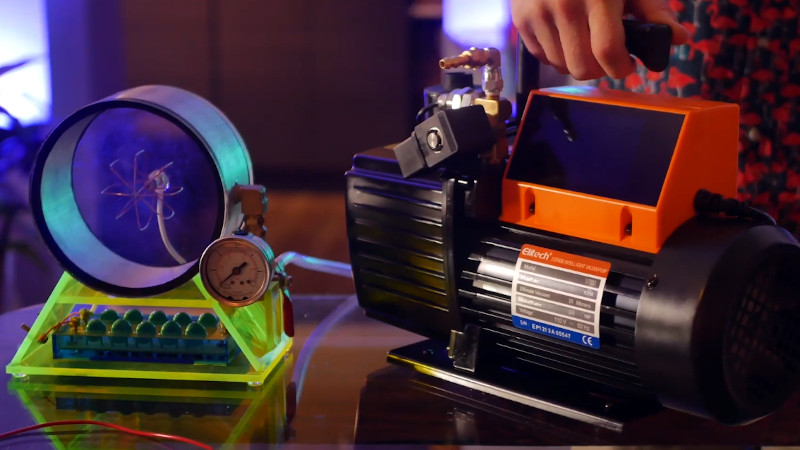We’ve seen our fair share of Farnsworth–Hirsch fusors over the years — these high-voltage devices can get ions cooking to the point of achieving nuclear fusion even on a hobbyist’s budget, and even though they won’t solve the world’s energy problems, they certainly make for an impressive light show. While “simple” to build in the relative sense, the examples we’ve seen in the past have still been bulky contraptions supported by a cart full of complex gear befitting a nuclear reactor.
Which is why the fusor [Jay Bowles] recently completed is so impressive. As you can see in the latest Plasma Channel video which we’ve placed below the break, this desktop “star in a jar” not only features an incredibly low part count, but looks more like a movie prop than anything you’d expect to find in a physics lab. If you ever considered building a fusor of your own but were put off by the size and complexity of existing designs, you’ll definitely want to check this out.

The decidedly non-fusor look of this creation can be attributed, at least in part, to [Jay]’s well-known love of building things out of multi-colored acrylic sheets. But you’ve also got to give credit to the transparent walls of the vacuum chamber, which offer breathtaking views of the plasma field surrounding the electrode. In a traditional fusor you’d usually expect a tiny view-port popped in the side of beefy metal tank, but in this case its almost the other way around.
Now to be clear, the build wasn’t without its issues. Building the 40 kilovolt epoxy-potted voltage multiplier was no problem for [Jay] given the sort of projects he’s used to, but this was the first time he’d tried to work with a vacuum. As you might expect, that meant some trial-and-error surrounding everything from how to seal the connections to the strength of the pump used to pull down the chamber. Still, after a few false starts, he was treated with the mesmerizing glow of confined plasma.
[Jay] says the next step is to introduce some deuterium into the chamber, so stay tuned for an update. Much like the multi-stage ion thruster he put together last month, we expect to be a project that’s going to be popping on Plasma Channel regularly as improvements are made. There’s also a good chance we’ll be hearing more about these builds when [Jay] takes the stage at the 2022 Hackaday Supercon.
















Really cool. I think the white Teflon tape is ok for liquid seals, there’s yellow tape for gas seals (I could be wrong).
They are all PTFE / Teflon. The only difference, besides color, is the thickness so you don’t need to wrap the fittings as much.
Wrong. There’s silver stuff which has nickel in it for use with stainless steel fittings to avoid galling during assembly/disassembly.
That’s a nice xray tube :) Never gonna have any real fusion at such low vacuum levels though…
The half-value attenuation level of 40KV X-rays is about 25mm of living tissue, and 40KV is ionizing radiation.
You also have to account for the total energy and the attenuation of the plastic, but generally speaking holding your hands around this thing for any length of time is probably not a good idea.
I’m not usually a safety nanny, but like to point out where safety is a concern and the maker is unaware.
Is this such a situation? Anyone who works with X-rays professionally care to comment?
The photo shows hands around it, but I wonder if it is Photoshopped.
Because he mentions in the video keeping a 4 foot (>1m) distance.
40kV could make some serious X-rays but to get 40keV you have to let those electrons first pick up the energy, by accelerating the entire way from cathode to anode, and then get them to dump almost all of it at once, often by wacking into a nice dense hunk of tungsten. This requires a pretty darn hard vacuum, or else your electrons will just barely get going before crashing into a parked nitrogen molecule (rinse, repeat) and that just gives off a lot of nifty blue and violet light. From the looks of it, there’s a whole lot of that latter thing happening.
Safety-wise, I’d be more worried about getting shocked directly from the HV. Or, tritium. He did say ‘tritium’ didn’t he? Maybe in 1985 you can buy that at the corner drugstore, but isn’t that stuff a little hazardous?
Even the tritium in my old watch has double half lifed itself since 1985.
Wikipedia could be lying to me, but it says at 10-3 hPa the mean free path for electrons is already 10 cm. If so the electrons should be able to ram into the inner cage at full speed.
So that’s a little worrying then
Today you can easily buy tritium keychain.
Used to. About 10-12 years ago they were 99c from the usual suspects, now the same ones go for 8-10 bucks. Out of curiosity I bought one of the new ones and it is as dim as my original 99c model so they are from the same supply of tritium or maybe even the same manufacturing run.
Tell me you didn’t watch the video without telling me you didn’t watch the video. He uses a radiation detector and doesn’t detect anything
I’m sure you could get some soft X-rays from this (40KeV or lower energy), but a “Fusor” producing neutrons? I don’t think the accelerating field is symmetrical enough to get useful acceleration.
If the vacuum chamber were spherical, or if there were a second spherical wire grind, those could be used to accelerate the ions toward the center of the inner grid.
All I see is ionization around the single spherical cage, with no pin point of white light dead center of that.
It is cool though, and looks awesome.
This is the first video. He doesn’t use any hydrogen in this video. It is just about getting the hardware to the state where it can generate plasma.
He’s planning to add the hydrogen feed and whatever else needed to make it fuse. That’ll be a second video.
From what I understand (although I’ve seen some disagreement on the point), it’s not so much that fusors accelerate nuclei toward the center; rather, there’s a concentration of electrons in the center, and hot nuclei are confined within that potential well until they collide.
So, the symmetry of the field will make a difference, but it’s not nearly as critical as if you were trying to directly focus ion beams at a single point. Even if you could do that, you’d be spending almost all your energy firing superfast nuclei into the walls of your vacuum chamber.
I’ve built a fusor in the past, mine was in a bell jar. Got a measurable, albeit tiny, neutron flux out of it too.
I’m pretty sure the one in the video is not fusing or capable of fusing in its current form. The cool light show around the outer grid is indicative of it being at too high a pressure and in glow discharge. Fusion also requires the HV supply to be pretty beefy – capable of 10’s of mA at 40kV and I’m not sure the dinky voltage multiplier is up to it.
Looks cool though.
Where’s the other half? A Fusor normally has and inner and outer grid (or use the metallic vacuum chamber wall as the outer grid), whereas this only has a single grid and an insulator as the chamber. Even if the cylinder section were lined with a conductor you’d just get a solenoid layout rather than a fusor (which you want to be spherical unless you want to do a lot of extremely obtuse math and modelling).
The aluminium chamber is probably the ground. A fusor doesn’t have to be symmetrical, that’s just the typical geometry people go for.
For instance, here’s an analysis of a cylindrical geometry with two magnetically shielded rings instead of a grid:
https://arxiv.org/abs/1510.01788